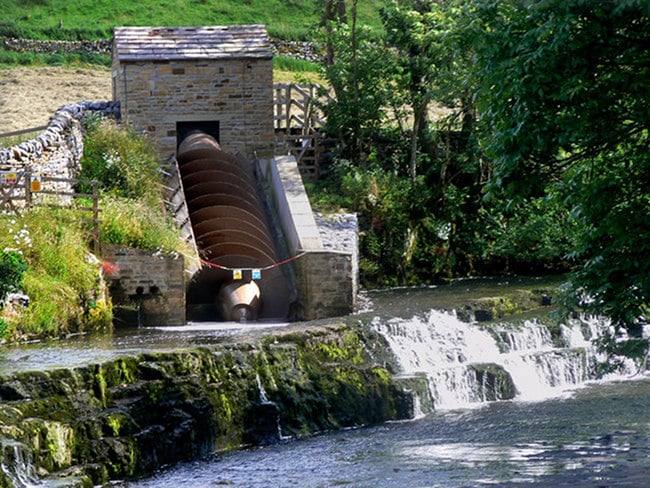This article is more than 1 year old
Move over, Mythbusters: Was Archimedes an ancient STEVE JOBS?
Happy 2,300th, old man... Beware of turtleneck-wearing Greeks?
The 'Death Ray'

The so-called "Death Ray", illustrated on the front page of a Latin edition of Alhazen's Thesaurus opticus (click to enlarge). Picture source: Wikimedia Commons
Archimedes is also said to have devised a giant crossbow of some sort, to further harry the Roman fleet.
And then there’s the “death ray”, an item so intriguing Mythbusters devoted two episodes to it.
Diodorus Siculus described it as follows:
The old man then devised an hexagonal mirror, and at an appropriate distance from it set small quadrangular mirrors of the same type, which could be adjusted by metal plates and small hinges. This contrivance he set to catch the full rays of the sun at noon, both summer and winter, and eventually, by the reflection of the sun's rays in this, a fearsome fiery heat was kindled in the barges, and from the distance of an arrow's flight he reduced them to ashes.
Remember how we said Diodorus Siculus isn't super-reliable? Plutarch's better regarded, but didn't mention the death ray. He's not the only source not to do so.
Was it real? Ancient writers did love to embellish details, or pick the best bits of a story. If you doubt that assertion, consider the many variations between the four gospels. We suggest such an exercise not to call their content or origins into question, but instead to offer a second example of ancient biography of a single person written by different authors and featuring different versions of events.
Accounts of Archimedes’ death are quite uniform and show us he was a rather unusual chap. Rome eventually defeated Syracuse and as legionaries roamed the streets came upon an old man who seemed rather distracted. Troops challenged him, but Archimedes asked for more time to complete the mental arithmetic that so consumed him, unaware of the imminent danger posed by Rome’s conquering army. A Roman quickly lost patience and Archimedes ended his days on the end of a gladius, the steel sword used by Rome’s infantry.
The turning of the screw

The Bainbridge hydro-electric project - modern-day implementation of the Archimedes screw.
© Copyright Anthony Harrison, licensed for reuse under this Creative Commons Licence.
Archimedes’ screw is also worth a mention. Essentially a helix around a shaft, if the device’s bottom is placed in water and its central shaft turned, water will rise to the top.
In the ancient world, when muscle and sinew – either of man or beast – was the only source of energy***, a device like the screw would have been invaluable.
But did Archimedes invent the screw? It’s impossible to say, although as he wrote on spirals, hydrostatics and how to calculate the biggest sphere one can fit inside a cylinder, he clearly understood its principles very well.
Assuming he went to Egypt, your correspondent's personal hypothesis is that Archimedes would have had ample opportunity to see the water-drawing technologies that civilisation developed during its thousands of years living with the Nile’s seasonal fluctuations. We know the Egyptians were engineering-savvy enough to build the pyramids. Might they also have concocted a screw?
One water-drawing gadget we know the Egyptians devised is the shaduf, a device that sees a lever/stick popped on an axle supported by two vertical struts. The lever has a weight on one end and a bucket on the other, an arrangement brought into modern times as a drinking bird trinket.
Shaduf users pull the bucket-bearing side of the lever down, an easy task thanks to the wonders of mechanical advantage. Once the bucket reaches water – shadufs are placed next to a water source – the user lets the bucket fill, then lets go, at which point the weight on the lever's opposite end pulls it skywards without any effort.
Water is thus drawn with rather less effort than would otherwise be the case, making the shaduf a tremendously useful machine - so useful we know Egyptians used them from at least 2000 BC.
My theory is that seeing shadufs at work set Archimedes' mind whirring. His ability to codify the maths and physics of such machines led, eventually, to his various weapons. Other inspiration came from seeing, or hearing of, ancient siege engines.
Armed with little more than an unfinished classics degree and a suspicious mind, your correspondent therefore wonders if Archimedes may not have been quite the innovator he's painted. Might he instead have been something of an ancient Steve Jobs, inasmuch as both went to a technological hot spot (Xerox PARC/Egypt), beheld wonders (the WIMPS GUI/shadufs) and then brought them to the outside world in a form more elegant and functional than had yet been seen? ®
* Originally written in Doric Greek (for those of you experiencing Google Translate fails.)
** "Any object, wholly or partially immersed [submerged OR partially submerged] in a fluid, is buoyed up by a force equal to the weight of the fluid displaced by the object." In On Floating Bodies, he added the clarification that for the object which had been dropped in the fluid, the volume of displaced fluid was equal to the volume of the object.
*** Your correspondent is aware of ancient water wheels at sites like Barbegal, but they’re a story for another day.
